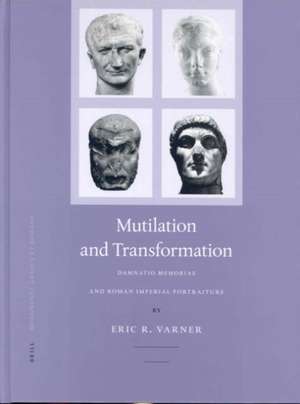Mutilation and Transformation: Damnatio Memoriae and Roman Imperial Portraiture: Monumenta Graeca et Romana, cartea 10
Autor Eric Varneren Limba Engleză Hardback – 28 iun 2004
Din seria Monumenta Graeca et Romana
- 18%
 Preț: 1534.41 lei
Preț: 1534.41 lei -
 Preț: 300.91 lei
Preț: 300.91 lei - 18%
 Preț: 924.37 lei
Preț: 924.37 lei - 18%
 Preț: 868.11 lei
Preț: 868.11 lei - 18%
 Preț: 714.22 lei
Preț: 714.22 lei - 18%
 Preț: 725.77 lei
Preț: 725.77 lei - 18%
 Preț: 736.23 lei
Preț: 736.23 lei - 18%
 Preț: 870.98 lei
Preț: 870.98 lei - 18%
 Preț: 1002.53 lei
Preț: 1002.53 lei - 18%
 Preț: 854.03 lei
Preț: 854.03 lei - 18%
 Preț: 866.42 lei
Preț: 866.42 lei -
 Preț: 164.14 lei
Preț: 164.14 lei -
 Preț: 187.13 lei
Preț: 187.13 lei - 18%
 Preț: 695.10 lei
Preț: 695.10 lei - 18%
 Preț: 558.46 lei
Preț: 558.46 lei - 18%
 Preț: 1100.17 lei
Preț: 1100.17 lei - 18%
 Preț: 1067.28 lei
Preț: 1067.28 lei - 18%
 Preț: 773.01 lei
Preț: 773.01 lei - 18%
 Preț: 659.86 lei
Preț: 659.86 lei - 18%
 Preț: 590.66 lei
Preț: 590.66 lei -
 Preț: 318.99 lei
Preț: 318.99 lei -
 Preț: 147.18 lei
Preț: 147.18 lei - 18%
 Preț: 582.92 lei
Preț: 582.92 lei - 18%
 Preț: 1094.14 lei
Preț: 1094.14 lei - 18%
 Preț: 998.20 lei
Preț: 998.20 lei
Preț: 1570.14 lei
Preț vechi: 1914.80 lei
-18% Nou
Puncte Express: 2355
Preț estimativ în valută:
300.46€ • 321.28$ • 250.51£
300.46€ • 321.28$ • 250.51£
Carte indisponibilă temporar
Doresc să fiu notificat când acest titlu va fi disponibil:
Se trimite...
Preluare comenzi: 021 569.72.76
Specificații
ISBN-13: 9789004135772
ISBN-10: 9004135774
Pagini: 462
Dimensiuni: 227 x 293 x 32 mm
Greutate: 1.65 kg
Editura: Brill
Colecția Brill
Seria Monumenta Graeca et Romana
ISBN-10: 9004135774
Pagini: 462
Dimensiuni: 227 x 293 x 32 mm
Greutate: 1.65 kg
Editura: Brill
Colecția Brill
Seria Monumenta Graeca et Romana
Public țintă
All those interested in Roman history, Roman sculpture, condemned emperors, and concepts of memory, as well as art historians, historians, and classicists.Notă biografică
Eric R. Varner, Ph.D. (1993) in Classics, Yale University is Assistant Professor of Art History and Classics, Emory University. He has published on Roman portraits, including the catalogue From Caligula to Constantine: Tyranny and Transformation in Roman Imperial Portraiture (Atlanta, 2000).
Recenzii
" [This work] combines the best of 'old school' portrait studies (typologies) with a critical outlook and due consideration given to the significance of these images as historical documents." Andreas Kropp in AWE 8 (2009)
